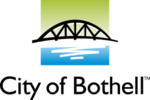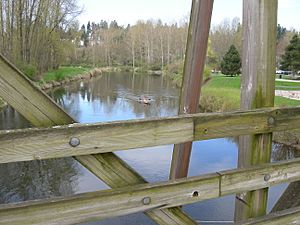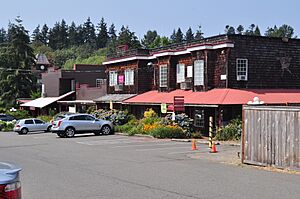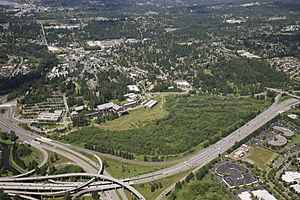Bothell, Washington facts for kids
Quick facts for kids
Bothell, Washington
|
||
|---|---|---|
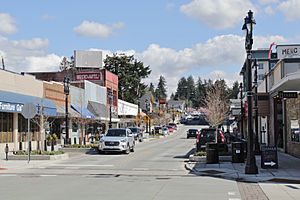
Main Street in Bothell
|
||
|
||
| Motto(s):
Welcome to Bothell for a day, or a lifetime
|
||
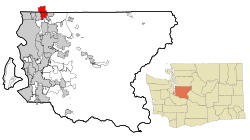
Location of Bothell within King County
|
||
| Country | United States | |
| State | Washington | |
| Counties | King, Snohomish | |
| Incorporated | April 14, 1909 | |
| Government | ||
| • Type | Council–manager | |
| Area | ||
| • Total | 13.64 sq mi (35.3 km2) | |
| • Land | 13.64 sq mi (35.3 km2) | |
| • Water | 0.00 sq mi (0 km2) | |
| Elevation | 75 ft (23 m) | |
| Population
(2020)
|
||
| • Total | 48,161 | |
| • Estimate
(2023)
|
50,212 | |
| • Density | 3,530.87/sq mi (1,363.28/km2) | |
| Time zone | UTC-8 (PST) | |
| • Summer (DST) | UTC-7 (PDT) | |
| ZIP code |
98011 (King), 98012, 98021 (Snohomish), 98041 (P.O. boxes)
|
|
| Area code(s) | 425 | |
| FIPS code | 53-07380 | |
| GNIS feature ID | 1512020 | |
Bothell is a city in Washington state, located in both King and Snohomish counties. It's part of the Seattle metropolitan area, found near the northeast end of Lake Washington. In 2020, about 48,161 people lived there.
The city sits along the Sammamish River, which was once home to the native Sammamish people. Bothell was started in 1870 and officially became a town in 1909. It used to be known for logging and farming. Later, it became a place where people lived and then traveled to work in bigger cities like Seattle. Today, Bothell is a hub for biotechnology and high-tech companies. It is also home to the University of Washington Bothell, which opened in 1990. The city has been updating its downtown area in recent years, adding more homes and businesses.
Contents
History of Bothell
The area around the Sammamish River was first home to the Sammamish people. They had a main village near where Bothell is now. Later, settlers arrived and started farms and logging businesses.
In 1870, the first land claims were made in what is now Bothell. George Brackett started a logging business in 1877. He also built a sawmill and a dock for steamboats.
In 1884, David Bothell bought land from Brackett. He and his sons built a home and a shingle mill. The town was named after the Bothell family in 1888. At that time, Bothell had hotels, lumber mills, and a school.
The Seattle, Lake Shore and Eastern Railway came to Bothell in 1888. This helped the town grow quickly. By the late 1880s, Bothell had a telegraph service, stores, and a doctor. Many new residents were immigrants from Scandinavia and Eastern Europe.
Becoming a Town and Early Growth
Bothell officially became a town on April 14, 1909. George Bothell, David Bothell's son, became the first mayor. The town had about 599 residents.
In 1911, a fire destroyed many buildings on Main Street. This led to the creation of a fire department in 1913. The Pacific Highway was finished through Bothell in 1912. This road connected Bothell to Everett and Seattle.
After the railroad and highway arrived, steamboat traffic on the Sammamish River decreased. The river was straightened in 1916. The water level of Lake Washington also dropped, making it harder for boats to use the river.
By the 1920s, farming replaced logging as the main industry. A new high school opened in 1923. During the Great Depression, new buildings like a city hall were built.
Modern Bothell Takes Shape
After World War II, Bothell grew a lot as people moved to the Seattle metropolitan area. New housing areas and schools were built. In 1954, Bothell started adding nearby areas to its city limits.
Bothell became a city in 1960 because its population grew past 1,500 people. The city's sewer system was completed that year. Interstate 405 was finished in 1968. This highway helped Bothell become a "bedroom community," where people live and commute to work in other cities.
In the 1980s, the North Creek Valley area became a center for high tech companies. In 1990, the University of Washington Bothell opened its campus in the city. Bothell also added the Canyon Park area in 1992, which nearly doubled its population. This brought many more technology and biotechnology businesses to the city.
Bothell in the 21st Century
In the 2000s, Bothell started a plan to improve its downtown area. This included building new roads and adding more homes and businesses. Construction began in 2010. A new city hall opened in 2015.
A big fire in downtown Bothell in 2016 damaged many businesses. Main Street was rebuilt to be a shared space for cars and people. During the COVID-19 pandemic, a part of Main Street was closed to cars. This helped businesses and became a popular outdoor gathering spot.
Geography of Bothell
Bothell is located along the Sammamish River, close to where it flows into Lake Washington. It is one of a few cities in Washington that are in two counties: King and Snohomish. The city covers about 13.64 square miles of land. Most of Bothell is suburban, with areas for homes, parks, and businesses.
The city has several hills and wetlands. North Creek and Swamp Creek flow through Bothell. These creeks are important for fish like Kokanee salmon and Chinook salmon. The highest point in Bothell is Nike Hill, which is 510 feet above sea level.
The University of Washington Bothell has restored a large wetland area. This wetland is now home to many animals, including large groups of crows. The university even hosts an annual "Crow Watch" event to observe them.
Population and People
Bothell is the 26th largest city in Washington state. Its population grew a lot in the 1950s, 1990s, and 2000s. Between 2010 and 2020, Bothell's population increased by over 40 percent.
Many different people live in Bothell. A large number of residents are Asian Americans, especially from India and China. About 20 percent of people in Bothell were born outside the United States.
In 2021, the average household income in Bothell was higher than the county averages. People in Bothell also tend to live longer than the average for King County and Washington state.
Economy and Jobs
| Rank | Employer | Employees |
|---|---|---|
| 1 | Northshore School District | 4,525 |
| 2 | AT&T Mobility | 1,838 |
| 3 | Seagen | 1,655 |
| 4 | Philips Ultrasound | 1,205 |
| 5 | University of Washington Bothell | 799 |
| 6 | T-Mobile US | 601 |
| 7 | AGC Biologics | 525 |
| 8 | Fujifilm Sonosite | 516 |
| 9 | 388 | |
| 10 | City of Bothell | 384 |
Bothell's economy has changed over time. It started with logging and farming. Then, it became a place where people lived and traveled to work in Seattle.
Since the 1980s, Bothell has become a major center for high tech and biotechnology companies. These companies create many jobs in the city. Bothell has the second-largest biotechnology hub in Washington state.
Many companies in Bothell work on things like:
- Developing new medicines (like Seagen and AGC Biologics)
- Making medical equipment (like Philips Medical Systems and Fujifilm Sonosite)
- Creating laser equipment for medicine and defense (like Lockheed Martin's Aculight)
- Providing phone and internet services (like AT&T Mobility and T-Mobile US)
- Working on computer technology (like Google)
Most people who live in Bothell travel to other cities for work. However, many people also travel into Bothell for jobs at these companies.
Culture and Fun
Bothell is a diverse city with many different cultures. It has a Sikh temple, a regional mosque, and the first Hindu temple in the Pacific Northwest.
Arts and Creativity
Bothell has public art, especially in downtown and on the university campus. The city has an Arts Commission that helps promote art. There's an art gallery at the new city hall.
Downtown Bothell has an art walk where you can see art in different businesses. There are also murals on downtown buildings that show Bothell's history.
The Northshore Performing Arts Center is Bothell's largest venue for shows. It opened in 2005 at Bothell High School and can seat 600 people.
Events and Festivals
Bothell hosts many fun events throughout the year. These include:
- The Fourth of July parade, also called the Freedom Festival.
- An Arbor Day celebration.
- Trick-or-treating for Halloween.
- A Winter Porch Light Parade in December, which includes lighting a Christmas tree.
- Outdoor concerts at the Bothell Landing amphitheater in the summer.
- Night markets on Main Street.
Other events include a block party and brewfest sponsored by the university. There's also "Sustainamania" to promote sustainable living. A weekly community market, the Bothell Friday Market, started in 2019.
In 2007, many people gathered to celebrate local American Idol contestant Blake Lewis. Bothell was also named one of the "Nicest Places in America" by Reader's Digest in 2018.
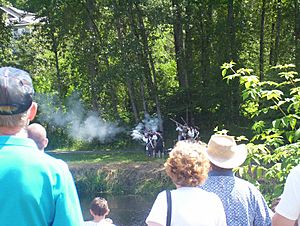
Library and History
Bothell's public library is part of the King County Library System. The first public library in Bothell opened in 1925. A new, larger library opened in 1995.
Bothell has several historic places. The Bothell Historical Museum is located in the Hannan House at the Park at Bothell Landing. It shows what a late 19th-century home looked like and shares items from the city's past.
Parks and Outdoor Fun
Bothell has 26 parks, trails, and open spaces. These areas cover about 403 acres. The city's Parks and Recreation Department organizes activities like sports leagues, concerts, and classes.
The Sammamish River Trail runs through Bothell. It's a popular path for hiking and biking. This trail connects to other regional trails, like the Burke–Gilman Trail and the North Creek Trail.
- Blyth Park is the city's oldest park.
- The Park at Bothell Landing is a 14-acre park with historic buildings and a footbridge.
- North Creek Forest is a large nature preserve with forests and wetlands. It's home to many birds and animals.
Bothell also has sports fields, like the Doug Allen Sportsfields and the North Creek Sportsfields. Centennial Park is in the northern part of the city.
Education
The Northshore School District serves Bothell and nearby areas. It is one of the largest school districts in Washington. There are 12 public schools within Bothell city limits.
Bothell High School opened in 1907. It was renovated in 2008 and now has a performing arts center. Other high schools that serve Bothell residents include Inglemoor High School and North Creek High School.
Bothell also has several private schools, including Christian schools and Montessori schools.
Colleges and Universities
Bothell is home to two colleges that share a campus:
- Cascadia College is a two-year community college.
- University of Washington Bothell (UW Bothell) is one of three campuses of the University of Washington. It serves about 6,000 students.
UW Bothell opened in 1990. The shared campus with Cascadia College opened in 2000. UW Bothell started as a school for students who had already completed two years of college. In 2006, it became a four-year university.
Getting Around Bothell
Bothell is located where Interstate 405 and State Route 522 meet. Interstate 405 is a major highway that goes around Seattle. State Route 522 connects Bothell to Seattle and other towns. Other highways in Bothell include State Route 524 and State Route 527.
Public transportation in Bothell is provided by different bus services:
- King County Metro has local and express bus routes.
- Sound Transit Express offers express routes to Seattle and other cities.
- Community Transit serves Snohomish County, connecting Bothell to towns like Lynnwood and Everett.
There are also park-and-ride lots where people can leave their cars and take the bus. Future plans include new bus rapid transit lines through Bothell by 2027. In 2019, Bothell also started an electric scooter sharing program.
Images for kids
-
The Bothell public library, operated by the King County Library System
See also
 In Spanish: Bothell para niños
In Spanish: Bothell para niños


